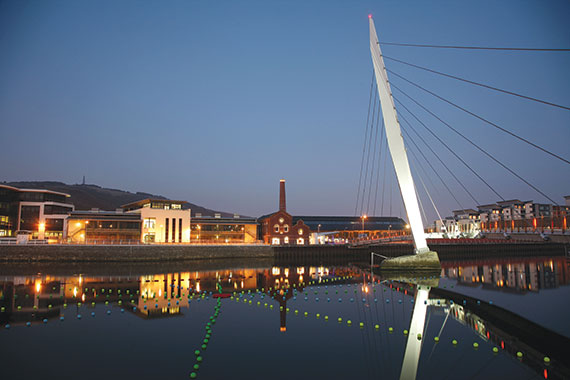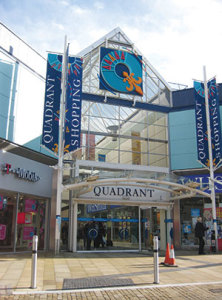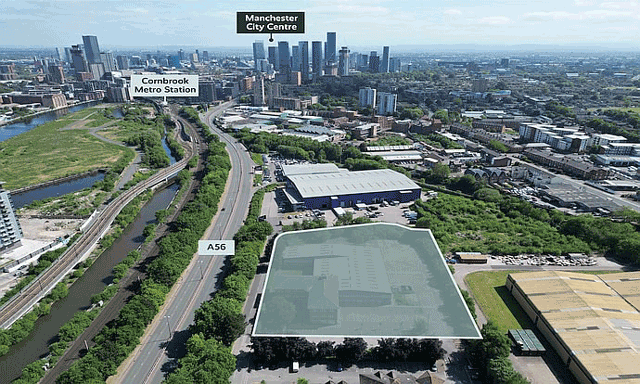Albert Einstein said the definition of insanity is doing the same thing over and again and expecting different results.
The £1bn, 23-acre retail development of the former St David’s Shopping Centre area in Swansea, proposed by Hammerson in a pre-credit crunch 2007, weren’t the first plans to be abandoned. Centros Miller, MEPC, Simons and Tarmac – which first earmarked a 300,000 sq ft retail development in 1994 – have also proposed and then abandoned developments at the site.
Swansea council is still experiencing the aftershocks of Hammerson walking away from the project last year. The developer is “considering its options” for its £10m revamp of the edge-of-town Parc Tawe shopping area after a row in the summer over the council’s trading restrictions.
Concerned the likes of M&S and Debenhams may up sticks from the city centre, the council blocked Hammerson for 12 years from approaching certain stores, which it found unacceptable. Not long afterwards, council leader David Phillips resigned.
But now it seems Swansea has learned its lesson. Instead of pinning its hopes on a gargantuan shopping scheme, the council is looking to a series of smaller but more numerous projects to transform the tired-looking city centre.
A retail and leisure strategy published in 2013 by Strategic Insight, which superseded an unfortunately timed 2007 effort, recognised that, although shopping is a major part of the city centre offer, Swansea must also start to offer events that create a buzz and attract people of all ages. This strategy is feeding into a revised framework agreement in the final stages of development, updated with the help of DTZ, masterplanners Chapman Taylor, and Vectos (highways and movement).
The council hopes to put a revised framework before the cabinet in December and, if approved, key sites – such as St David’s Shopping Centre (see box) – will be marketed early next year. Huw Mowbray, the council’s property development manager, says the St David’s scheme will be less ambitious than the Hammerson project, reflecting a changed way of thinking.
“We won’t be putting all our eggs in one basket with one big scheme. There will be a number of schemes,” he says. “The framework review is looking at what we need to do to make a step-change while having a series of deliverable projects. The key aspects are living and working, getting more people in the core city centre – this is part of the change.”
Yet in recent decades Swansea has seen a steady of drain of people working inside the city centre to outside. Swansea really is “twin town” in terms of the two university campuses under construction: Swansea University’s Bay Campus on a disused BP site three miles away in the Baglan Bay area, and University of Wales, Trinity Saint David’s SA1 Swansea Waterfront campus on Fabian Way.
Chris Sutton, of JLL Cardiff and chair of CBI Wales for 2014-15, says Swansea needs to maximise the potential from these student-related developments. “The Fabian Way corridor is the future employment growth zone,” he says. “So it needs a more aggressive approach – CPOs and clearance of the remaining old engineering works; investment in infrastructure and masterplanning.”
The problem for the city centre is further exacerbated by the quality of office stock on offer. Lee Mogridge regional director for Lambert Smith Hampton, explains: “Swansea must be unique in UK terms of having no grade-A office stock in the city centre and very limited availability in the proposed office core at SA1, with the majority of sites being sold off for higher-value uses such as residential and hotels,” he says.
“If a company wants to relocate to Swansea with a requirement for 60,000 sq ft there’s nowhere to go other than a couple of buildings in the enterprise park, but that’s five miles away and there’s no public transport. Prime office headline rents are £14.50 per sq ft for new grade-A SA1 development and not many deals are done at that rate. If you move to the city centre, it is £7-8 per sq ft, so a speculative developer would need a pretty compelling case.”
Mogridge notes Llys Tawe, a 25,000 sq ft office on SA1 Swansea Waterfront, was the last significant letting in the city, achieving a rent of £13 per sq ft in February 2013 on a 10-year lease. “Where quality stock is available in the right locations, occupier demand will follow,” he says. “There’s no need to provide iconic buildings. The best thing Swansea could do is refurbish some of the existing stock, much of which is in a poor state. The demand is there.”
JLL’s Sutton says the city centre needs an action plan. “To my mind, the key issue to be addressed is that SCC has retained the freehold estate under its ground lease policy. As the 99-year ground leases from the 1950s and 1960s run down then there is little incentive for the ground leaseholders to invest and refurbish for the future.
“Swansea is competing for institutional funding with other regional UK city centres and, frankly, there are better prospects elsewhere when you factor in the ground leases. It needs a fundamental review.”
However, the council is listening to what the property sector is saying, assures its corporate strategic manager, Geoff Bacon. “These 99-year lease properties do struggle to gain funding but we’re more than happy to respond to any request to extend the leasehold interests and help increase the book value or move them on,” he says.
“We have a fiduciary duty to gain best value and we do what we can around that. The fact we have five of these properties in the city centre going through this process at the moment suggests we are not being greedy.”
Hammerson and Urban Splash entered a co-operation agreement with Swansea council in 2008 for a £1bn scheme at the site of the St David’s Shopping Centre, including a 600,000 sq ft shopping centre and 1,000 residential units.
Urban Splash exited the joint venture in 2009 when the housing element was dropped and in 2013 the project was dead after Hammerson formally dropped its retail plans.
Swansea council and the Welsh government bought the complex in December 2011 and set about demolishing vacant buildings with a view to creating a car park, now completed, and a mixed-use regeneration scheme.
“We will be going out very early in the new year on a multi-site basis that will relate to taking forward the revised strategy,” says Paul Ellis, senior director of DTZ. “Commercial leisure, such as cinemas and restaurants, will form a significant part of the brief to increase dwell time and improve the night-time economy, and St David’s is one of these key sites; there is plenty of occupier interest already.”
Huw Mowbray, the council’s property development manager, says the scheme will be more deliverable than Hammerson’s. “That included knocking down Debenhams and creating a new mall. It was something of its time and we’ve moved on. This has a much smaller focus scheme; it will not include, for example, Tesco.
“The leisure component will be significantly higher. We would like to see a cinema – that’s what the retail study says – supported by restaurants, public squares and a link to the sea via Oystermouth Road.”
Ellis says there needs to be a link to the neighbouring Quadrant shopping centre. “The issue is how you best link the St David’s development into the Quadrant. We’ve had some very productive discussions with the owner, Coal Pension Properties, and the council about joining into the proposals which come forward for St David’s, potentially an extension site.”













